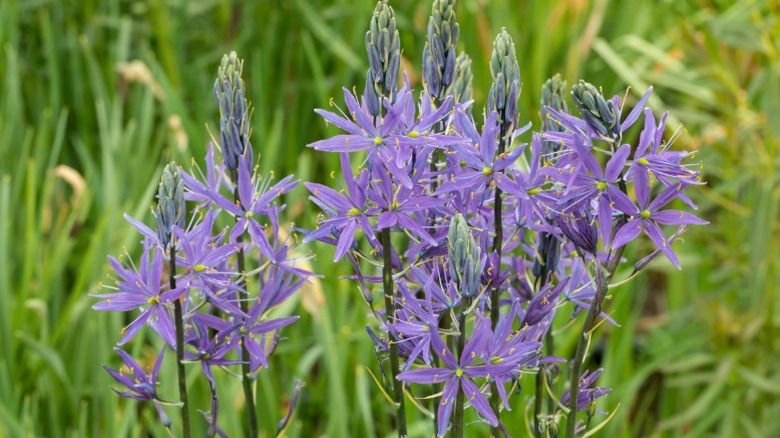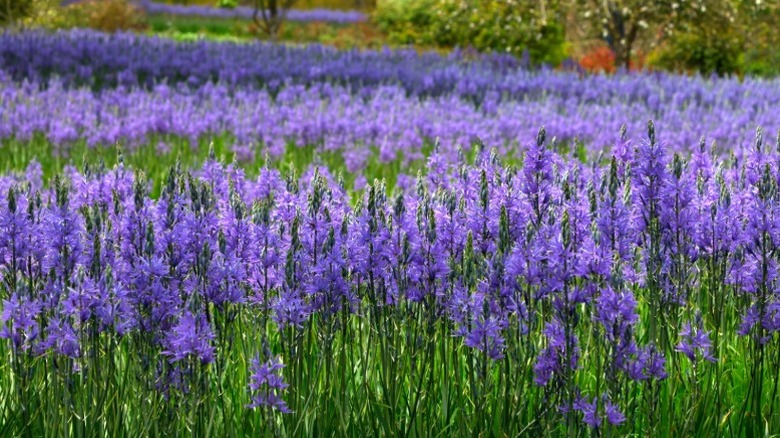The Summer-Blooming Wildflower That Brings Dazzling Blue-Purple Flowers To Garden Beds
Wildflowers like purple coneflower (Echinacea purpurea), black-eyed Susan (Rudbeckia hirta), and scarlet beebalm (Monarda didyma) are some of the hardiest species to grow, plus you won't spend too long establishing them in your yard. However, if you're looking for a less common colorful wildflower you can grow in your garden, try large camas (Camassia leichtlinii). With their beautiful blue-purple blooms that bring color to summertime garden beds, they're a bold choice.
A plant native to the western U.S., large camas are also known as great camas or Leichtlin's camas. For years, this flower has served as an important food source (via the edible bulbs) for native groups on the west coast of North America. But nowadays, gardeners also grow large camas as beautiful ornamental additions to their landscaping.
Large camas feature star-shaped flowers on long green stems. These stalks burst into bloom from late spring to summer, rising between 3 and 4 feet above the green foliage that spreads about 2 feet for a single plant. Large camas are often mistaken for common camas (Camassia quamash), but the darker purple of large camas sets them apart. Typically, most home gardeners source bulbs instead of growing them from seed. It can take six long years of hard work to get large camas to flower when grown from seed!
Tips for successfully cultivating large camas
The bulbs of the large camas should be planted in fall or early winter. Putting bulbs in the ground at this time is necessary because they need a period of cold stratification to sprout. Planting depth depends on the size of the bulb. Larger, more mature bulbs can be put 4 to 6 inches down in the ground. Spacing recommendations range from 4 to 8 inches apart. To create a natural look, account for at least 9 plants per square foot. If you intend to plant large camas throughout a sizable area, like a meadow, grab bulb planting tools that make gardening so much more convenient.
Aim for fertile and acidic soil for this species, with consistent moisture. The bulbs should be kept in damp conditions during its active growing season. However, once the weather starts to warm in the summer, drier conditions that mimic their natural habitat are ideal. With adequate moisture, this species will grow well in different soil types, even clay.
Although you can harvest large camas from the wild, the best way to get your own is by purchasing commercially-grown bulbs. Harvesting wild bulbs can contribute to environmental issues and might be restricted without permits. Popular as an ornamental flower, a variety of cultivars are available commercially, including some with unique color profiles. For a classic look, try 'Caerulea' with its light blue blooms. You can also mix-and-match other colors, like the white cultivar 'Alba,' into your garden beds.
Ideas for growing large camas in your home garden
Giant camas are hardy from zones 5 through 9, with the best growth possible in areas close to its native habitat, particularly the pacific coast from California to British Columbia. However, they have found popularity across the U.S. and even worldwide. This upright species is a fresh way to update a tidy garden bed by giving it dimension with tall flower stalks. It's also excellent if you want to expand a wildflower garden. If you have intentions to turn a patch of land into a prairie, be sure to include large camas. Not only will they establish well in the right conditions, they play well with other native prairie plants, like chocolate lily, wild strawberry, and yarrow.
Large camas naturally grow in areas with lots of moisture, like wet meadows and the sides of streams, which makes them a good match for a pondscape. Add them along the edges of a water garden where they'll get plenty of moisture, but not be bogged down. They're definitely a flowering plant that thrives in soggy soil, but make sure that it is well-draining to avoid too much wetness. Bulbs need time to dry out in the summer to avoid issues like disease and rot.


